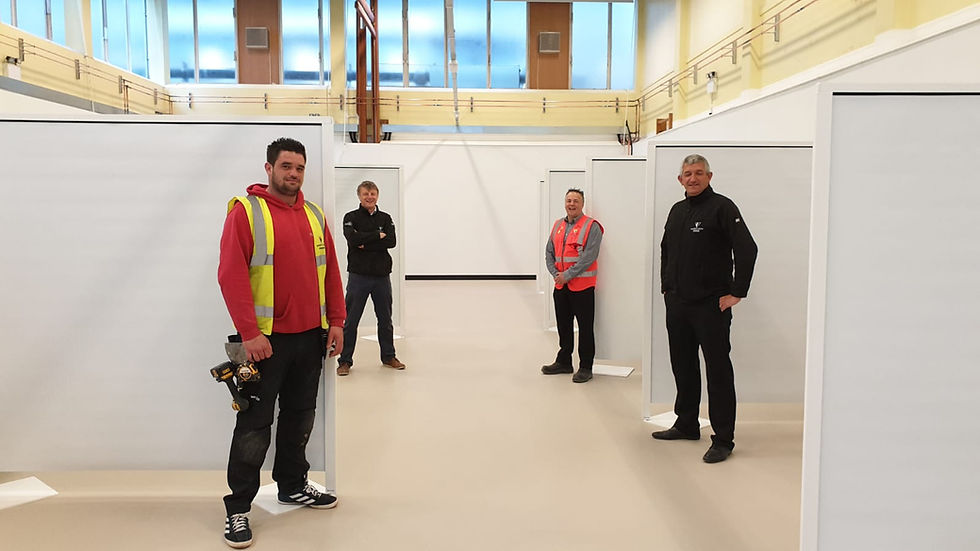The impact of Covid-19 on the future of building design
- Niche Magazine

- Sep 17, 2020
- 4 min read
Contracting group highlights the long and short term impact coronavirus has had on building design.
We're now living in a world of social distancing and masked outings. But the impact of Covid-19 isn’t just those changes staring us in the face.
There are more subtle, underlying ramifications that are yet to be explored completely – such as alterations in building design.
The question is, are Covid-related changes we are now seeing in building design here to stay, or a passing trend as the industry attempts to guide itself back to normality when the pandemic is over?
Contractor Willmott Dixon's Matt Linekar and Stephen Moore give us a run through of the changes they're up against.
A change in requirements
The need for proper circulation and fresh air to reduce the risk of contamination has never been more prominent, especially in the education sector where large groups of students must move around the building during regular intervals.
This requirement also means that designers must think about the importance of flexibility to be able to purge the air in classrooms. They must also consider window patterns and wall fans and their impact on the acoustics of these rooms.
The care sector is another one that must adapt to changing times. Designers must consider the importance of ventilation in communal areas or corridors that could be the hub of cross contamination.
Many care homes are now drawing on primary care regimes and lobbying rooms to protect infected patients, altering facilities to increase the safety of both staff and residents.
But, with providers in these sectors already struggling to source funds and a potential vaccine set to hit the UK in 2021, many of these measures may not be instigated.
Stephen Moore, preconstruction manager at Willmott Dixon, said: "Many businesses are struggling to weigh up the short-term benefits with the financial impact that it can have on the outgoings of a project.
“This response is being reflected by local authorities. Spatial problems are undeniable when discussing social distancing in schools. But, councils don’t have the money, space or desire to make long-term changes to facilitate social distancing measures, and we are seeing many private sector companies take a similar stance."

Perfecting the process
It’s not just the elements of design that have been impacted by Covid-19, but also the process in which these designs are created.
The informal nature of construction sites means that social distancing is often hard to maintain.
With a mountain of competing factors to contend with such as the need for team work, the variety of jobs that have to be completed simultaneously and strict time scales that have to be adhered to, contractors have had to make dramatic changes to ensure staff stay socially distant while working on projects.
This has meant for many firms, including Willmott Dixon, that focusing on off-site fabrication has helped the design process.
Matt Linekar, head of building services at Willmott Dixon, said: “One of the key things that the Covid-19 pandemic has accelerated is off-site manufacturing and the different ways in which we might be able to utilise modern methods of construction (MMC).
“MMC is already a hot topic for the industry and the pandemic has simply enhanced this – and the last few months has given us the opportunity to explore the options in more detail and will no doubt continue to play a part in construction projects in the longer-term.”
Long-term or short-term
Very quickly, firms were forced to adopt new ways of working to help protect their teams and prevent the spread of Covid-19, all while ensuring that essential building projects did not stall.
Matt added: “Distancing on site, and within the wider community, is probably here to stay. As an industry, we are having to find ways to accommodate that, but whether or not there will actually be long-term design implications remains to be seen.
“The short-term response has been one of meeting practical challenges on sites and moving forwards with a different way of working.
"The reality is that the construction industry is a very competitive marketplace – potentially even more so as the Government has positioned the built environment at the forefront of the recovery strategy.
“The Government is encouraging a ‘build back better’ approach but there are inevitably cost implications associated with that and without legislation to demand improved standards and a force for change.”

Should the approach to building design change?
Stephen added: “Moving towards a focus on whole life cost is an important first step but that will rely heavily on customers adopting a shift in mindset, thinking about overall value rather than initial outlay.
"It’s challenging, especially against a backdrop of a damaged economy and already stretched budgets, especially within the public sector.
“Sustainability will be key, but that is something that has been put somewhat on the backburner for the time being as we navigate through the Covid crisis.
"As an industry, so often the focus is on cost and designing to meet the minimum standards rather than considering the longer-term impact of a building. Moving forwards, it would be great to see a move away from considering a higher initial cost, but a better performing building, as ‘uneconomic’ and seeing customers investing in better quality products.
“The manner in which we live and work has had to adapt to the implications of Covid-19 and design does not seem to be addressing a long-term fix at the moment. Maybe this will change over time.
"It is arguable that we will need to accommodate less densely populated workplaces with more space for flexible working.
"Consumers will begin to demand something different and design will change to recognise that.”







